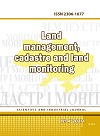Implementation of the residual productivity principle in land valuing methods
DOI:
https://doi.org/10.31548/zemleustriy2019.04.06Abstract
Land valuation is based on numerous principles, among which the principle of residual productivity plays a leading role. According to this principle, the current land value is determined by the residual income from its possible future use in the future, taking into account the costs and the time required to obtain this income. In addition, the residual productivity principle is fundamental in revealing the immanent uncertainty of land valuation due to the multiplicity of its value, each of which will be true in assumptions and false in other cases.
The application of this principle in the land valuation has become constitutional in the formation and development of its methodological apparatus.
The article discusses the evolution of land valuation methods based on the residual productivity principle – from traditional extraction methods and residual capitalization to discounted cash flow methods – and analyzes the main advantages and limitations of their use in valuation practice. The necessity of moving from deterministic to stochastic cash flows models and supplementing them with optional pricing models, which best reflect the modern understanding of the residual nature of land value and taking into account its inherent uncertainty, has been proved.
Keywords: residual land productivity, uncertainty, deterministic and stochastic cash flow models, optional pricing models.
References
GN 1 Valuation certainty / RICS Valuation - Professional Standards. (2012). London: RICS, 87-90.
Valuation Uncertainty: Technical Information Paper 4. (2013). London: IVSC, 21.
VPGA 10 Matters that may give rise to material valuation uncertainty / RICS Valuation - Global Standards. (2017). London: RICS, 143-145.
Drapikovskyi, O., Ivanova, I. (2018) Problema neoprelelennosti v ocenke zemli i sposoby ee reshenija [The problem of uncertainty in the land valuation and its solving methods]. Monetary valuation of land in Ukraine: achievements, problems, prospects: international scientific-practical conference. Kyiv, November 8-9, 2018, 35-39.
Drapikovskyi, O., Ivanova, I. (2019) Immanentnaja neopredelenost ocenki zemli [Immanent uncertainty of land valuation]. Land of Belarus, 1, 27-30.
Cost Approach for Tangible Assets: Technical Information Paper 2. (2012). London: IVSC, 27.
Eckert, J. K. ed. (1997) Оrganizacija ocenki i nalogooblozhenija nedvizhimosti [Property Appraisal and Assessment Administration]: in 2 vol. Moscow: Appraisal Academy, 1, 384.
International Valuation Standards (2017). London: IVSC. 128.
Dutailly, J-C.(1971) Les valeurs foncieres eu region parisienne. Recherche d'un modele. Cahiers de l'Institut d'Amenagement et d'Urbanisme de la Region parisienne, 25, 31.
IVS 410 Development Property / International Valuation Standards (2019). London: IVSC, 132.
Britton, W., Davies, K., Johnson, T. (1989). Modern Methods of Valuation of Land, Houses and Building: 8th Edition. London: Estates Gazette, 768.
Таrasevich, Е. (2000). Analiz investicij v nedvizhost [Real Estate Investment Analysis]. Saint Petersburg: МКS, 428.
Treasury Board of Canada Secretariat. (1999). Analiz vygid i vytrat [Benefit-cost Analysis Guide]. Kyiv: Osnovy, 175.
International Valuation Standards (2011). London: IVSC, 128.
Pogodin, S. (2012) Novye metody ocenki zemel'nyh uchastkov - modeli real'nyh opcionov [New land valuation methods - real options models]. Valuation Issues, 3, 20-25.
Drapikovskyi, O., Ivanova, I. (2018). Nelvizhimoe imuschestvo i ego stoimost: monografija [Real Property and its value: monography]. LAP LAMBERT Academic Publishing, 159.
Titman, Sh. (1985). Urban Land Prices Under Uncertainty. American Economic Review, 75 (3), 505-514.
Geltner, D. (1989). On the Use of the Financial Option Price Model to Value and Explain Vacant Urban Land. Journal of the American Real Estate & Urban Economics Association, 17 (2), 142-158.
https://doi.org/10.1111/1540-6229.00479
Shapiro, E., Davies K., Mackmin D. (2013). Modern Methods of Valuation: 11th Edition. London & New York: Routledge, 246-247.
European Valuation Standards: Eighth Edition. (2016): Brussels: TEGoVA, 370.
Pomykacz, M., Olmsted, C. (2013). Options in Real Estate Valuation. The Appraisal Journal, Summer, 227-238.
Downloads
Additional Files
Published
Issue
Section
License
Relationship between right holders and users shall be governed by the terms of the license Creative Commons Attribution – non-commercial – Distribution On Same Conditions 4.0 international (CC BY-NC-SA 4.0):https://creativecommons.org/licenses/by-nc-sa/4.0/deed.uk
Authors who publish with this journal agree to the following terms:
- Authors retain copyright and grant the journal right of first publication with the work simultaneously licensed under a Creative Commons Attribution License that allows others to share the work with an acknowledgement of the work's authorship and initial publication in this journal.
- Authors are able to enter into separate, additional contractual arrangements for the non-exclusive distribution of the journal's published version of the work (e.g., post it to an institutional repository or publish it in a book), with an acknowledgement of its initial publication in this journal.
- Authors are permitted and encouraged to post their work online (e.g., in institutional repositories or on their website) prior to and during the submission process, as it can lead to productive exchanges, as well as earlier and greater citation of published work (See The Effect of Open Access).


